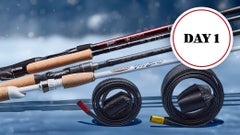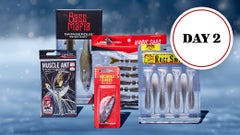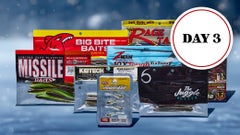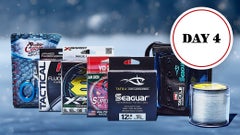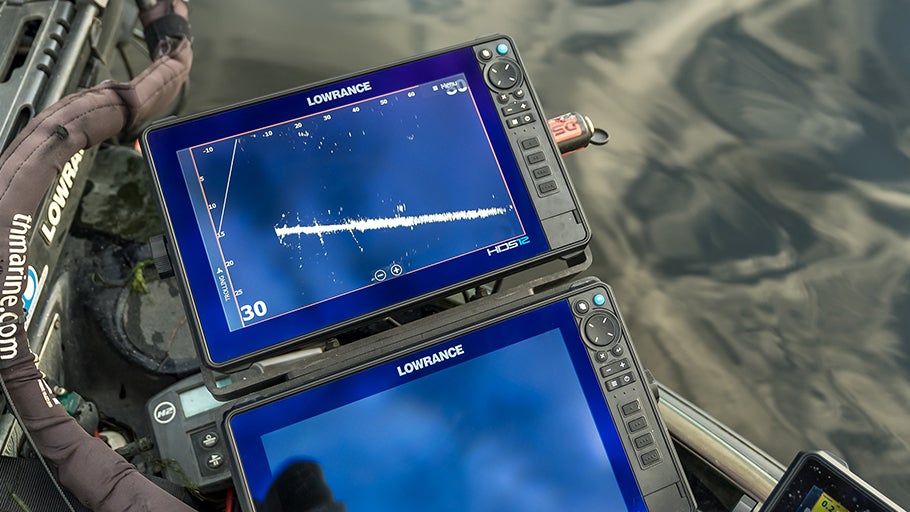
Hover Strolling and Mid Strolling Gear Guide
Whether you’ve heard it referred to as hover shotting, moping, or spine rigging, hover strolling is a deadly finesse technique that allows soft plastics to ‘hover’ horizontally in place or fall with irregular gliding and spiraling action. Hover strolling rigs are great for presenting lures to suspended bass, and with the advent of forward-facing sonar, they’ve become increasingly popular for spotting and stalking finicky fish floating in the water column.
A traditional hover strolling setup consists of a small 90-degree finesse hook, nail weight, and compact plastic, while mid-strolling rigs are more of the power fishing cousin that employs heavier jigheads, which are worked more aggressively. In this gear guide, we’ll take a closer look at the best tackle to fish with this hot finesse technique, identify the key differences between hovers trolling and mid-strolling, and learn how to apply them to your fishing.
Strolling Rods
Spinning tackle is often preferred for hover strolling to help anglers cast super lightweight lures and manage thin-diameter fishing lines commonly used with this technique. For classic hover rigs, maximizing casting distance is always at a premium, so a longer 7’4” – 7’6” spinning rod coupled with light to ultra-light power and fast taper is ideal to deliver longer casts and load the blank properly during the cast and hookset.
With mid-strolling applications, you’re often working the lure more with the rod tip, so a shorter 6’8” – 7’ rod offers increased handling, and you may need a slightly heavier medium-light or medium power rating based on the size of the tackle being used. Bait finesse casting rods with similar specs are also a great choice for presenting hover rigs, especially if you’re using the rod to work the bait or using heavier tackle and want the added leverage of a casting rod hookset.
Strolling Reels
Hover strolling is a very methodical and target-oriented style of fishing, so speedy gear ratios are less important but come in handy if you need to quickly take up line to set the hook or make a new presentation. Any 2000–3000 size spinning reel is ideal for hover strolling, but if you’re using extremely thin diameter line, the smaller spool of a 1000–1500 reel can help improve castability.
Bait finesse casting reels also work well because they are compact, extremely comfortable to palm, and allow anglers to make quick accurate pitches with shallow spools which are made specifically for casting lightweight lures with accuracy. Ultimately, hover strolling is characterized by finesse-oriented tackle, so regardless of what type of reel you choose, it's imperative to have a smooth-starting drag system that delivers consistent pressure when a big fish gets on the line.
Strolling Line
In recent years, a braid-to-leader combination has become the preferred line choice for bass anglers looking to maximize performance when fishing finesse tactics on spinning gear. The no-stretch attributes of an 8–15lb braided mainline offer increased sensitivity with a smooth, thin, and rounded construction that greatly extends your casting distance with ultra-lightweight lures.
Keep in mind, when faced with high fishing pressure or extremely clear water conditions, straight fluorocarbon may be necessary to conceal your line around spooky open-water fish. For hover strolling techniques, a 4–6lb fluorocarbon leader or mainline is perfect for pairing with ultra-light wire hover hooks, where heavier jig heads, hooks, and mid-strolling tackle may call for fluorocarbon lines in the 10–14lb range.
Modifications & Rigging
Designed to present soft plastic minnows with a natural horizontal posture, the secret to the hover strolling rig is the 90-degree hook and placement of the eyelet behind the head of the bait, which helps impart an erratic rolling action. The basic hover strolling method involves threading the hook point into the top of the plastic slightly behind the nose of the bait, bringing the point out of the tail where the shank lies flat within the body, and the line tie comes straight out of the head. Next, simply take a nail weight and insert it into the nose of the bait, placing it beneath the shank of the hook. For a more detailed rigging explanation, check out our How-To Setup the Hover Strolling Rig video!
As hover strolling evolves and expands, manufacturers have developed unique weight-integrated hooks that eliminate the need for nail weights and allow for larger hook and weight sizes. This one-piece form of terminal tackle, aptly known as a hover rig, has opened the doors for anglers to ‘mid-stroll’ deeper depths, use a wider range of baits, and shake the bait more aggressively with the rod tip on the retrieve. Scope-specific jig heads also deserve a mention in the hover strolling category, as they’ve become increasingly popular for anglers looking to increase lure visibility on live sonar when presenting lures to a target on the screen.
To maximize the action of your hover strolling baits consider rigging up with a Loop knot to allow for added freedom of movement with your favorite hover hooks, jig heads, or soft plastic trailers that need more movement. The Loop Knot is easy to learn and tie quickly while you're out on the water, and can help trigger more bites in finesse or high pressure fishing situations when fish desire a more reaslsitic action from your bait. Check out our detailed step-by-step video below on how to tie the Loop Knot!
Colors
Hover strolling rigs are most commonly paired with fluke-style baits, soft plastic jerkbaits, or pin-tailed minnows to accurately mimic baitfish roaming the water column, so shad and white color variations are always a great choice. If you live in parts of the country where the fish are keyed in on perch, gobies, or golden shiners, feel free to expand your arsenal to include some match-the-hatch color patterns that resemble the target forage.
As hover and mid-strolling techniques continue to sweep tournament bass fishing with technology advancements in forward-facing sonar, it’s important to note that you don’t need electronics to fish these presentations effectively. Whether you’re fishing ponds or fan casting open water, these ultra-finesse tactics remain deadly anytime you locate fish and need to slowly work the bait to trigger a bite. Hover strolling isn't necessarily going to replace all your favorite finesse tactics, but it's another tool to add to a savvy angler’s ever-expanding arsenal to help you remain effective during the cold-water months of the season!
Suggested Articles






































































































